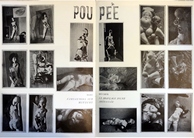The Visual Vocabulary of Chitra Ganesh: Femininity, Sexuality, and Abjection in Ganesh's Visual Art
By
2013, Vol. 5 No. 10 | pg. 2/2 | « Ganesh does not limit herself, however, to comics and popular media to express the themes of abjection. In her installation piece Inside Pandora (2008) (Fig. 2), Ganesh defines the possibility of intersection between femininity, sexuality, and abjection. First, Ganesh places a figural representation of a nude goddess who displays overt attributes of feminine sexuality with her large breasts and hirsute pubis. From here, however, Ganesh diverges from sexualizing the female body for catering to the male gaze and replaces male heterosexual desire with queer revisions. By inserting a third eye and multiple arms, Ganesh invokes traditional Hindu mythology. The text “Behind her Thousand Moons” also directly refers to a rite of passage in Indian culture that glorifies the time when a person has witnessed 1000 nights by their 83rd birthday.8 Thus, Ganesh uses reference to a traditional vocabulary but then clearly diverges from it to expose the underlying consciousness of mortality and humanity that pervades mythology. In Pandora #2, the myth of Pandora as a female who has unleashed evil is directly assaulted onto the viewer with direct visual connections to the female body. Emerging from the figures vagina is an umbilical cord that morphs into a pipe of a hookah, twisted and warped in the same manner as the plaits in the figures hair; this connection is extended through Ganesh’s incorporation of real hair that extends past the plane of the image onto the connecting wall of the installation cube. Connecting the umbilical cord to the hookah pipe and then to real hair is an exercise in cognitive dissonance for the viewer; it results in a process by which the viewer struggles to simultaneously separate and distinguish these three forms while at the same time following their progress across the visual plane. Figure 2: Chitra Ganesh, Inside Pandora, 2008.  Other forms of new media utilized by Ganesh come in the form of phase lenticular prints as moving digital works that directly confront the viewer with the problems of defining notions of ideal feminine beauty through the capitalist Bollywood film empire.10 Ganesh inserts texts of her own writing onto still images from the 1978 Raj Kapoor film Satyam Shivam Sundaram to create her 2009 work Ghostwriter (Fig. 3). 11The protagonist’s face is disfigured from an accident with burning oil during her childhood and she hides this deformity from her lover with the folds of her sari. Ganesh goes beyond the superficial disfiguration of the skin, however, and reveals the sinews and flesh underneath the skin in the second phase. The viewer is compelled to look beyond the basic disfiguration of beauty in the first phase and instead must reflect on the constitutive elements of the body in the second phase with an image that resists any implication of sexuality and beauty. By denying this sexual response, Ganesh questions the role of the Bollywood film industry to project the ideal of female beauty and subsequently capitalize on the commoditization of beauty for the heterosexual male gaze. Figure 3.1: 
Figure 3.2 
In Ganesh’s representations of female figures and the abject undercurrent that informs these representations, the body is to be viewed as a source of conflict. At once a source of sexual desire, the feminine body is frequently morphed into the grotesque to “assert the corporeal existence of the body and its mortality…grotesque bodies subvert and resist social practices that tend to suppress individual differences or constrain freedom of expression.”12The grotesque is a vehicle for expressing abjection for Chitra Ganesh, but implicit in the abject qualities of the art is a feminist understanding of how sexuality is constructed within and outside of the body. In regards to sexual desire, feminist critic Judith Butler claims that the abject must be conflated with homosexuality by the dominant heterosexual regime in order to maintain its own conception of the self, which reveals the “fantasies and anxieties of heterosexual culture.”13 However, in Ganesh’s work, queerness and feminine sexuality are not mutually exclusive. Though Butler’s assessment that abjection is often intrinsically tied to homosexual or queer culture is correct, it is not apparent in Ganesh’s digital works, comic strips, or digital works that this abject culture outside of the dominant hierarchy and within the realm of femininity is opposed to heterosexual desire; rather it is a critique of how heterosexual desires are made prevalent through cultural forces of nationalist identity as seen in mass media and Bollywood. If Kristeva’s notion that abjection must be equated with the maternal Other is to be adopted, then it follows that feminine sexuality can derive from this same source even when it becomes appropriated by the patriarchal forces of the male gaze. The feminine body is a particular source of both sexual desire and abject imagery as posited by Kristeva and thus can be used as a direct assault on the dominant visual culture. Chitra Ganesh plays a significant role in understanding the role of contemporary art as new form of social critique of dominant visual culture as her art challenges socially prevalent roles of femininity, sexuality and identity through the use of various media. By subverting the roles assigned to women by propagandistic mass media and nationalist sentiment through the use of abject imagery and grotesque, Ganesh interrogates the viewer on a direct visual level but also on a more pervasive, visceral, and psychological response. Incorporation of new media into her works allows for multiple grids of interpretation that stand independent form one another but are connected by similar themes; Ganesh’s strategic use of visual culture as an instrument for manipulation furthers her connection to the viewer and strengthens the viewer’s response. ReferencesCachia, Amanda. “Bearing Gifts: The Myth of Pandora” in Pandora’s Box. Dunlop Gallery, Regina, Saskatchewan, 2008. Ganesh, Chitra. “Artist’s Statement.” In Gopinath, Gayatri, “Chitra Ganesh’s Queer Re-Visions,” GLQ: A Journal of Lesbian and Gay Studies. Vol. 15: 3, 2003 Duke University Press. Gopinath, Gayatri. “Chitra Ganesh’s Queer Re-Visions,” GLQ: A Journal of Lesbian and Gay Studies. Vol. 15: 3, 2003 Duke University Press. Gutiérrez-Albill, Julián. “Desublimating the Body: Abjection and the Politics of Feminist and Queer Subjectivities in Contemporary Art.” Angelaki: Journal of the Theoretical Humanities, Vol. 13, No. 1, 2008. Kristeva, Julia. “Approaching Abjection” from Powers of Horror (1980) in The Portable Kristeva, ed. Kelly Oliver. New York: Columbia University Press, 2003. Robertson, Jean and Craig McDaniel. “The Body,” in Themes of Contemporary Art: Visual Art After 1980, New York: Oxford: Oxford University Press, 2005. 1.) Gopinath, Gayatri. “Chitra Ganesh’s Queer Re-Visions,” GLQ: A Journal of Lesbian and Gay Studies. Vol. 15: 3, 2003 Duke University Press, 470. 2.) Ibid, 470. 3.) Ganesh, Chitra. “Artist’s Statement,” in Ibid, 469-70. 4.) Kristeva, Julia. “Approaching Abjection” from Powers of Horror (1980) in The Portable Kristeva, ed. Kelly Oliver. New York: Columbia University Press, 2003, 230. 5.) Gutiérrez-Albill, Julián. “Desublimating the Body: Abjection and the Politics of Feminist and Queer Subjectivities in Contemporary Art.” Angelaki: Journal of the Theoretical Humanities, Vol. 13, No. 1, 2008: 67. 6.) Gopinath, 471. 7.) Kristeva, 232. 8.) Cachia, Amanda. “Bearing Gifts: The Myth of Pandora” in Pandora’s Box. Dunlop Gallery, Regina, Saskatchewan, 2008: 43. 9.) Guitérrez-Albilla, 72. 10.) For a critique of the male gaze as exemplified by the film industry, see Mulvey, Laura. Fetishism and Curiosity. London: British Film Institute, 1996. 11.) The moving image of the phase lenticular print may be viewed at <http://www.chitraganesh.com/newprojects2.html >. Accessed 6 November 2012. 12.) Robertson, Jean and Craig McDaniel. “The Body,” in Themes of Contemporary Art: Visual Art After 1980, New York: Oxford: Oxford University Press, 2005: 142. 13.) Guitérrez-Albilla, 69-70. Suggested Reading from Inquiries Journal
Inquiries Journal provides undergraduate and graduate students around the world a platform for the wide dissemination of academic work over a range of core disciplines. Representing the work of students from hundreds of institutions around the globe, Inquiries Journal's large database of academic articles is completely free. Learn more | Blog | Submit Latest in Visual Arts |
















